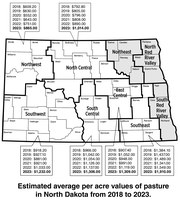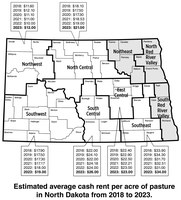North Dakota pastureland values increase faster than cropland values in 2023
(Click an image below to view a high-resolution image that can be downloaded)
North Dakota pastureland values were up 17.1% from 2022 to 2023 while pastureland rents were up 7.1% during the same time, says Bryon Parman, North Dakota State University (NDSU) Extension agricultural finance specialist.
Data for pastureland rents and values are from the North Dakota County Rents and Prices Annual Survey, found online at https://www.land.nd.gov/resources/north-dakota-county-rents-prices-annual-survey, and then put into weighted averages and NDSU Extension regions. The northern Red River Valley, southern Red River Valley and northeastern regions of North Dakota are excluded from the analysis due to low numbers of pastureland sales and rents as well as low livestock numbers.
“Of the more prominent livestock regions in North Dakota, the southeastern region had the costliest pastureland at $1,910 per acre, up 23.3% from a year ago, which was the largest gain,” says Parman. “However, while the southeastern region had the largest increase, all areas were up over 13% as far as pastureland values.”
The smallest increase was the north-central region up 13.9% from $890 per acre to $1,014 per acre. The other NDSU Extension regions saw increases between 14.9% and 17%.
Rents for pastureland were up as well.
“Pastureland rents are low in terms of dollars per acre compared to cropland values, so a $1 or $2 per acre change in the data can have a significant impact on the percentage changes, such as the northwestern region, which went from $10 per acre to $12 per acre,” explains Parman. “Therefore, the percentage changes in rental rates should be viewed with caution. However, the fact that pasture rents were up across the board and accompany a large increase in pastureland values, it is a justified conclusion that pastureland rents are increasing in North Dakota.”
The costliest rents in the state tends to be in the southeastern region at $34 per acre where stocking rates are a bit more dense, with the least costly being in the northwestern region where stocking rates tend to be lower.
The 17.1% increase in pastureland values is the largest single year increase in more than a decade. This increase is larger than that of 2014 and 2015 when feeder cattle prices hit record highs. Though cattle prices have been relatively strong over the last year or two, it has come with high feed costs as feed grain commodity prices have remained high.
“High feed costs may be partially driving pastureland prices as producers search for alternatives to buying feed for livestock, hoping instead to use grass as an alternative,” concludes Parman.
NDSU Agriculture Communication – April 4, 2023
Source: Bryon Parman, 701-231-8248, bryon.parman@ndsu.edu
Editor: Kelli Anderson, 701-231-6136, kelli.c.anderson@ndsu.edu



